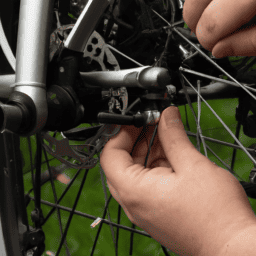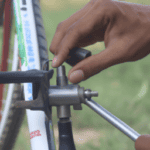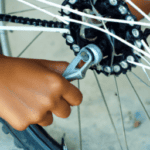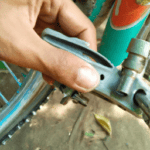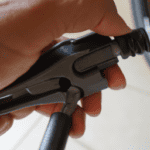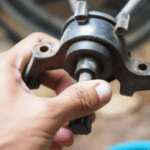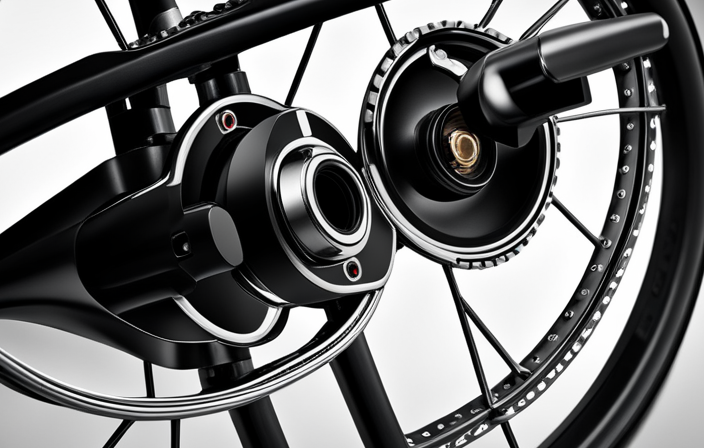As someone who rides bikes, I recognize how crucial it is to keep the braking mechanism in good condition. A key part of this system is the brake pads. These pads engage with either the rim or rotor, generating the necessary friction to decelerate or halt the bike. With use, brake pads might deteriorate and thus might need tuning to guarantee their optimal performance.
In this article, I will provide step-by-step instructions on how to adjust bicycle brake pads. Adjusting brake pads is a simple task that requires a few essential tools and a basic understanding of brake pad placement. By adjusting the brake pads’ placement, you can ensure that they make full contact with the rim or rotor, allowing for maximum stopping power. Additionally, adjusting brake pads can also prevent unnecessary wear and tear on the rim or rotor.
With the right tools and a little bit of patience, you can learn how to adjust your bicycle’s brake pads and keep your braking system in top condition.
Key Takeaways
- Proper tool selection is essential for adjusting brake pads.
- Brake pad positioning is crucial for optimal performance and preventing damage to pads and rims.
- Check alignment by spinning wheel and observing distance between pads and rim.
- Testing and troubleshooting brake system is necessary to ensure smooth and even stopping.
Gather Necessary Tools
Ready to get your bike’s brakes working like new? First things first, gather all the necessary tools! Proper tool selection is essential when adjusting your brake pads.
You’ll need an Allen wrench, a screwdriver, and a pair of pliers. Make sure the Allen wrench fits the size of the bolts on your brake caliper. The screwdriver should be the appropriate size for the adjustment screws on your brake pads. And pliers will come in handy when repositioning the brake pads.
The importance of brake pad positioning can’t be overstated. It’s crucial to ensure that the brake pads are aligned correctly for optimal performance. Proper positioning will also prevent damage to the brake pads and rims.
Once you have the necessary tools, it’s time to identify brake pad placement.
Identify Brake Pad Placement
First things first, take a good look at where those little rubber feet meet the wheel rim – it’s all about getting that contact just right. Identifying the correct brake pad placement is crucial to ensure an effective brake system.
Common mistakes include placing the brake pads too high or too low on the rim, or positioning them at an angle. Different types of brake systems may require different placement, so it’s important to consult the manufacturer’s instructions to ensure proper positioning.
To identify the correct placement, start by examining the brake pads and the rim. The brake pads should make contact with the rim at a perpendicular angle, and the entire surface of the pad should touch the rim evenly.
Here are a few key things to keep in mind when identifying brake pad placement:
- Ensure the brake pads are positioned at the same height on both sides.
- Check that the brake pads are centered on the rim, with equal spacing between the pads and the rim on both sides.
- Make sure the brake pads are not angled, but rather straight and perpendicular to the rim.
- Take note of any grooves or irregularities in the rim surface, as this may affect brake pad placement.
With these tips in mind, you should be able to identify the correct brake pad placement for your bike’s brake system.
Next up, we’ll move on to adjusting the brake pad placement for optimal braking performance.
Adjust Brake Pad Placement
Okay, so to adjust the brake pad placement on my bicycle, I need to follow these three key points:
First, I need to loosen the brake pad bolt that secures the pad to the brake arm.
Then, I need to align the brake pad with the rim of the wheel, making sure it’s centered and not rubbing against the tire.
Finally, I need to retighten the bolt to secure the brake pad in its new position.
It’s important to make sure the brake pads are properly aligned to ensure safe and effective braking.
Loosen Brake Pad Bolt
To start, simply loosen the brake pad bolt using a wrench or an Allen key. When adjusting the brake pads, proper positioning is essential to ensure maximum stopping power. This means that the brake pads should be placed in such a way that they make contact with the rim of the wheel at the correct angle. Over tightening the bolt can cause the brake pad to become misaligned, which can result in decreased performance and potentially dangerous riding conditions.
To help you achieve proper brake pad positioning, use the following table as a guide:
| Wheel Type | Brake Pad Placement | Angle of Contact |
|---|---|---|
| Road | 1-2mm below rim | 15-20 degrees |
| Mountain | 1-2mm above rim | 45-50 degrees |
| Hybrid | Midway between road and mountain settings | Midway between road and mountain settings |
By following these guidelines, you can ensure that your brake pads are in the correct position for optimal stopping power. Once you have loosened the brake pad bolt, the next step is to align the brake pad with the rim. This can be done by adjusting the position of the brake pad and tightening the bolt until it is snug.
Align Brake Pad with Rim
Now it’s time to get those pads perfectly in line with the rim of your bike wheel – it’ll feel like you’re achieving the impossible!
First, make sure the brake pad is at the proper distance from the rim. You can do this by using a piece of paper or business card to measure the gap between the pad and the rim. The distance should be about the thickness of a credit card. Adjust the brake pad by loosening the bolt holding it in place, moving it to the correct position, and tightening the bolt again.
Next, align the brake pad with the rim. Use the barrel adjuster on the brake lever to center the pad on the rim. It’s important to make sure the brake pad is not rubbing against the rim, as this can cause excessive wear and slow you down. To prevent brake rub, adjust the position of the brake pad so that it is parallel to the rim.
Check the alignment by spinning the wheel and looking for any areas where the pad is rubbing against the rim. Once you’re satisfied with the alignment, move on to the next step of retightening the bolt.
Retighten Bolt
Make sure you tighten the bolt securely to avoid any accidents while riding your bike. After aligning the brake pad with the rim, use a wrench to retighten the bolt that holds the brake pad in place. It’s important to ensure that the bolt is tightened securely so that the brake pad doesn’t move or shift during use.
In addition to tightening the bolt, it’s also important to lubricate the pivot point of the brake pad. This can be done by applying a small amount of lubricant to the pivot point and moving it back and forth to distribute the lubricant evenly.
Common mistakes to avoid include over-tightening the bolt, which can damage the brake pad and make it difficult to adjust, and using too much lubricant, which can attract dirt and grime and cause the brake pad to slip.
With the bolt tightened and the pivot point lubricated, you can now move on to the next step of checking the brake pad alignment.
Check Brake Pad Alignment
First, take a close look at the alignment of the brake pads. Common brake issues include misalignment of the brake pads, which can lead to poor braking performance. It’s important to regularly maintain your brakes to ensure they’re functioning properly and to prevent any potential accidents.
To check the alignment of the brake pads, start by spinning the wheel and observing the distance between the pads and the rim. The brake pads should be hitting the rim at the same time and with equal pressure. If this isn’t the case, use a wrench to adjust the alignment by loosening the bolt that holds the brake pad in place and moving it until it’s aligned with the rim.
Once you’re satisfied with the alignment, tighten the bolt and repeat the process for the other brake pad.
With the brake pads properly aligned, you can move on to testing the brakes and making final adjustments.
Test Brakes and Make Final Adjustments
Once you’ve ensured your safety, you’ll want to take your bike for a spin and feel the confidence that comes with properly functioning brakes.
While riding, you’ll want to test your brakes by squeezing them firmly to make sure they stop your bike smoothly and evenly. If you notice any issues, such as the brakes feeling spongy or uneven, it’s time to make some final adjustments.
First, check for brake pad wear. If the brake pads are worn down, they won’t be able to grip the rim properly and you’ll need to replace them.
If the pads are still good, try adjusting the tension of the brake cable. If the brakes are too loose, tighten the cable by turning the barrel adjuster clockwise. If the brakes are too tight, loosen the cable by turning the barrel adjuster counterclockwise.
If you’re still having issues, it’s time to troubleshoot further or seek assistance from a bike mechanic.
With properly adjusted brakes, you can ride with confidence and safety.
Frequently Asked Questions
How often should bicycle brake pads be replaced?
As an experienced cyclist, I know the importance of regularly inspecting brake pads for signs of wear and tear. The lifespan of bicycle brake pads varies depending on usage, but it’s recommended to replace them every 1,000 miles or so to ensure optimal performance and safety.
What is the best way to clean and maintain bicycle brake pads?
When it comes to cleaning and maintaining bicycle brake pads, there are a few key techniques and tips to keep in mind. Regularly wiping down the pads and rims, using rubbing alcohol or sandpaper to remove buildup, and checking for wear and tear can all help keep your brakes working smoothly.
Can different types of brake pads be used on the same bicycle?
When it comes to using different types of brake pads on the same bicycle, compatibility issues can arise. Performance comparison is important to ensure safety and effectiveness. It’s crucial to consult with a professional before making any changes.
How do you troubleshoot brake issues if adjusting the brake pads does not solve the problem?
If adjusting the brake pads does not solve brake issues, a brake system overhaul may be required. It’s best to seek professional bike repair services for this complex task, as it involves disassembling and inspecting various parts of the brake system.
Are there any safety considerations to keep in mind when adjusting bicycle brake pads?
Ensuring proper positioning and avoiding brake pad wear are critical for safe cycling. Before adjusting bicycle brake pads, consider these safety factors to prevent accidents and maintain optimal performance.
Conclusion
In conclusion, adjusting bicycle brake pads is a simple task that can be done with just a few tools and some attention to detail. By identifying the placement of the brake pads, making the necessary adjustments, and checking for proper alignment, you can ensure that your brakes are working effectively and safely.
As the old adage goes, "an ounce of prevention is worth a pound of cure."Taking the time to regularly adjust and maintain your brakes can prevent accidents and ensure that you have a smooth and safe ride. By following the steps outlined in this article, you can confidently adjust your bicycle brake pads and enjoy a safer and more enjoyable ride.
Remember to test your brakes and make any final adjustments before hitting the road. Happy cycling!
